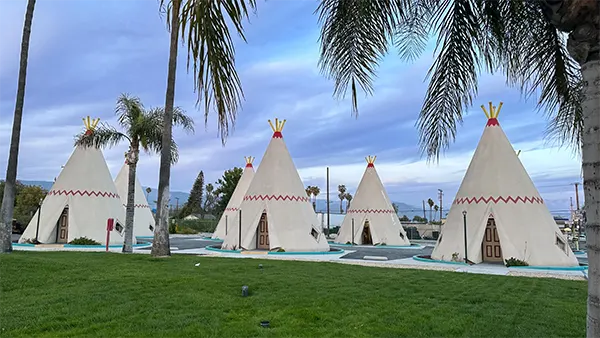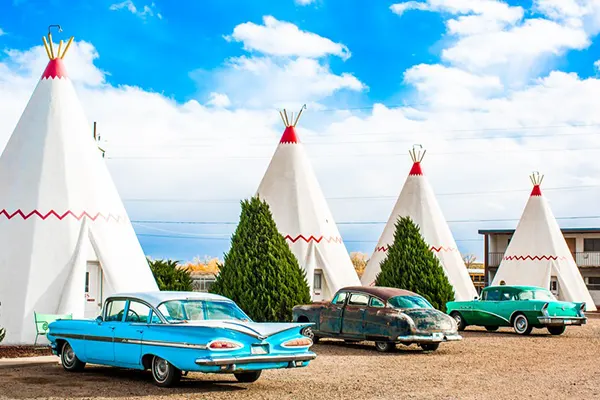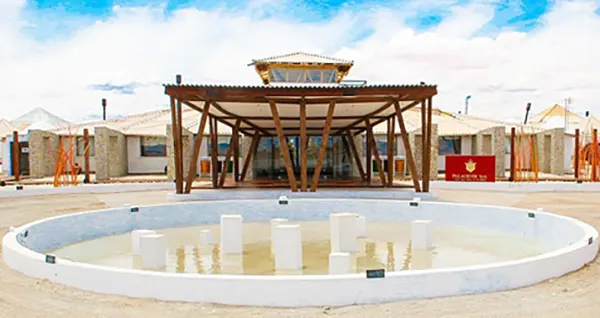
Wigwam Motel on Route 66: Iconic Tent-Style Cottages of America
The Wigwam Motel, one of the most recognisable landmarks along the historic Route 66, symbolises a golden era of American road travel. Built in the mid-20th century, its tent-shaped cottages remain a nostalgic reminder of freedom, adventure, and the open road. Today, this unique accommodation continues to attract travellers from around the world who want to experience an authentic piece of American history.
The Origins of Wigwam Motel
The Wigwam Motel was first conceived in the 1930s by architect Frank A. Redford, who was fascinated by Native American culture and sought to blend it with the growing trend of automobile tourism. His idea led to the creation of a chain of motels shaped like traditional teepees, offering comfort and novelty to motorists exploring the expanding American highway system. The first Wigwam Motel appeared in Kentucky in 1933, followed by others in Alabama, Arizona, and California.
The motels quickly became an icon of roadside architecture, representing a time when travelling by car was not only practical but romantic. Each Wigwam was made of concrete and steel, painted white with red tips, designed to resemble a Native American dwelling while providing modern comfort inside. This fusion of cultural symbolism and mid-century design made the motels both controversial and captivating.
Out of the seven original Wigwam Motels, only three remain today: in Holbrook (Arizona), Rialto/San Bernardino (California), and Cave City (Kentucky). These sites have been carefully restored and are now listed on the National Register of Historic Places, preserving their legacy for future generations of travellers.
The Architectural Design and Experience
Each Wigwam unit is a standalone concrete structure shaped like a conical tent, around 9 metres tall, offering a small but cosy interior. The rooms typically include a double bed, a bathroom, air conditioning, and vintage furnishings that reflect the charm of the 1950s. Despite their compact size, these cottages provide comfort and a sense of stepping back in time, appealing to nostalgia-seekers and design enthusiasts alike.
The exterior aesthetics of the Wigwam Motel play a major role in its attraction. Neon signage, classic cars displayed in front of the rooms, and retro details recreate the feel of mid-century Americana. For many visitors, staying at the Wigwam Motel is not just accommodation—it’s participation in living history, a journey into the culture of roadside travel.
Over the decades, the motel has also served as inspiration for pop culture references, including Disney-Pixar’s “Cars”, where the fictional “Cozy Cone Motel” clearly draws from the Wigwam’s distinctive design. Its playful yet nostalgic architecture makes it one of the most photographed roadside stops in the United States.
The Route 66 Connection
Wigwam Motel’s location along Route 66 is no coincidence. Known as the “Mother Road,” Route 66 connected Chicago to Los Angeles and became a lifeline for trade, migration, and tourism in the 20th century. During the post-war boom, countless families travelled westward, and motels like the Wigwam offered an affordable and memorable stay along the way.
The Holbrook Wigwam in Arizona became especially famous among Route 66 enthusiasts. Surrounded by desert landscapes, cacti, and vintage diners, it perfectly captures the atmosphere of classic road trips. The site has retained its retro character with original signage, antique furniture, and even restored classic cars parked in front of each wigwam.
Today, Route 66 travellers continue to seek out the Wigwam Motel as a must-see destination. It has become a cultural landmark celebrating American mobility, hospitality, and creative roadside architecture—a tangible link to the past in a world dominated by modern chains and standardised lodging.
Preservation and Modern Tourism
Restoring and maintaining a mid-century roadside attraction is no simple task. The surviving Wigwam Motels have undergone extensive restoration efforts funded by private owners, historical societies, and tourism grants. Maintaining authenticity while meeting modern standards such as Wi-Fi and climate control required careful planning and respect for original design.
In Holbrook, the Lewis family continues to manage the Wigwam Motel, balancing heritage preservation with business sustainability. Their work ensures that the property remains operational while retaining its original charm, offering guests an authentic retro experience without unnecessary modernisation.
As of 2025, the Wigwam Motel continues to attract both domestic and international visitors, especially those travelling the Route 66 Heritage Trail. It stands not only as a nostalgic destination but also as a symbol of preservation, showing that cultural icons of the past can thrive in modern tourism through dedication and respect for history.

The Legacy of Wigwam Motels in American Culture
The Wigwam Motel’s influence extends far beyond its physical structures. It represents an era when travel was driven by curiosity and optimism, when each mile brought new experiences. Its kitschy yet artistic architecture embodies the spirit of roadside innovation that defined America’s mid-century identity.
In an age dominated by global hotel chains, the Wigwam Motel offers something rare: individuality. Every stay feels personal, tied to the cultural geography of Route 66 and to the travellers who once crossed it in search of opportunity or adventure. This emotional connection is what keeps the motel relevant nearly a century after its creation.
Architectural historians and preservationists often cite the Wigwam Motel as one of the best examples of “Googie architecture” — a futuristic and playful style inspired by the optimism of post-war America. Its simple form, bright colours, and symbolic design make it both a time capsule and a living museum of American travel culture.
The Wigwam Motel Today
Visitors in 2025 can book a stay at the remaining Wigwam Motels through their official websites or major travel portals. Prices range from around $90 to $130 per night, depending on location and season, making it an affordable and unique accommodation option. The interiors preserve vintage aesthetics, with original wood furniture and mid-century décor complemented by modern amenities such as flat-screen TVs and air conditioning.
Many guests choose to stay specifically to capture the iconic photo of themselves beside the conical cottages and neon lights, sharing their experiences across social media. The motels have gained renewed popularity among younger travellers seeking authenticity and “retro Americana” experiences.
In 2025, the Wigwam Motel remains more than just lodging—it’s a tribute to creativity, individuality, and cultural memory. Its preservation reminds us that true heritage lies not only in grand monuments but also in everyday places that shaped how people lived, travelled, and dreamed across generations.




